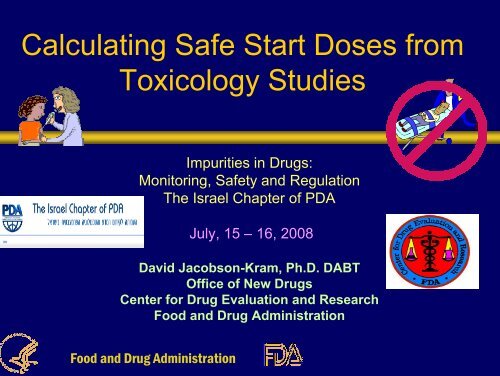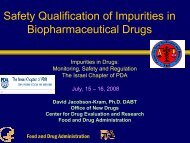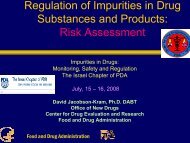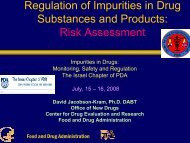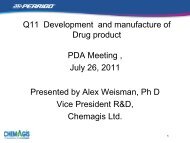Calculating l Safe Start t Doses from Toxicology Studies
Calculating clinical start dose from toxicology studies - The Israel ...
Calculating clinical start dose from toxicology studies - The Israel ...
- No tags were found...
You also want an ePaper? Increase the reach of your titles
YUMPU automatically turns print PDFs into web optimized ePapers that Google loves.
<strong>Calculating</strong> l <strong>Safe</strong> <strong>Start</strong> t <strong>Doses</strong> <strong>from</strong><br />
<strong>Toxicology</strong> <strong>Studies</strong><br />
Impurities in Drugs:<br />
Monitoring, <strong>Safe</strong>ty and Regulation<br />
The Israel Chapter of PDA<br />
July, 15 – 16, 2008<br />
David Jacobson-Kram, Ph.D. DABT<br />
Office of New Drugs<br />
Center for Drug Evaluation and Research<br />
Food and Drug Administration<br />
Food and Drug Administration
Food and Drug Administration<br />
July, 2005
CDER guidance on “start dose”<br />
‣ Selection of maximum safe starting dose for first-in-<br />
human trial (cf. Guidance for Industry: Estimating i the<br />
<strong>Safe</strong> <strong>Start</strong>ing Dose in Clinical Trials for Therapeutics in<br />
Adult Healthy Volunteers July 2005)<br />
‣ Relevant for small molecule or biologic therapeutics<br />
‣ Not intended to address dose-escalation or maximum<br />
clinical doses, or dosing in patient populations. p<br />
‣ Toxicity is to be avoided at the initial dose.<br />
‣ Approaches other than that described may be used (e.g.,<br />
PK/modeling); however, approach selected needs to be<br />
justified.<br />
Food and Drug Administration
FIM Dose Calculation<br />
‣ Identification of NOAEL; more sensitive<br />
species if more than one available, often one<br />
species for biologics<br />
i<br />
‣ Conversion of NOAELs to Human Equivalent<br />
<strong>Doses</strong> (using body surface area conversion<br />
factor)<br />
BSA-CF: converts mg/kg dose in animals to<br />
mg/m2 dose, then to mg/kg dose in human<br />
‣ Selection of more sensitive species (i.e.,<br />
lower HED when more than one species<br />
NOAEL available)<br />
Food and Drug Administration
<strong>Safe</strong>ty Factor<br />
‣ Application of safety factor<br />
default is 10, but may not be adequate in all cases<br />
Increase<br />
• Steep dose-response curve<br />
• Severe toxicity at doses above NOAEL<br />
• Non-monitorable toxicities<br />
iti<br />
• Toxicities with no premonitory signs<br />
• Irreversible toxicity<br />
• Unexplained death<br />
• Widely variable bioavailability in animals<br />
• Non-linear PK<br />
• Wide variability between species in doses or<br />
exposures eliciting toxicities<br />
• Less than optimal nonclinical study design/conduct<br />
• Novel therapeutic targets<br />
• Animal models with limited utility<br />
Food and Drug Administration
<strong>Safe</strong>ty Factor, continued<br />
Default of 10, may be decreased if:<br />
• Drug is a member of a well-characterized class, is<br />
being given according to an established clinical<br />
dosing regimen, and has similar PK/ADME and<br />
toxicity it profiles across species, including human.<br />
• Toxicities are easily predicted, monitored, and are<br />
reversible.<br />
• Dose-response for toxicity is not steep.<br />
• The NOAEL upon which the HED is based was<br />
determined in longer-term nonclinical studies; this<br />
assumes that toxicities are cumulative and were<br />
not observed early in the longer-term studies.<br />
Food and Drug Administration
Changes in start t dose<br />
‣ It is always acceptable (<strong>from</strong> a safety<br />
perspective) to use a clinical start dose lower<br />
than the MRSD.<br />
‣ Use of pharmacologically active dose (PAD)<br />
May use if lower than MRSD<br />
May be used to justify lowering the MRSD, e.g., in<br />
cases in which toxicity is due to exaggerated<br />
pharmacologic effects.<br />
Food and Drug Administration
History of <strong>Safe</strong>ty<br />
‣ Phase 1 clinical trials, especially in healthy<br />
subjects have a long history of safety.<br />
‣ With the exception of a few instances, the<br />
paradigms we currently use for selecting<br />
safe starting and stopping doses have<br />
served us well.<br />
‣ One glaring failure: TGN1412.<br />
Food and Drug Administration
Food and Drug Administration
Food and Drug Administration
Events in clinical trial<br />
‣ TeGenero contracts with Parexcel for a first<br />
entry into man study of monoclonal antibody,<br />
TGN1412.<br />
‣ Application received by MHRA on December 23,<br />
2005, trial authorized on January 27 th , IRB<br />
approved February 14 th , trial begun on March<br />
13 th .<br />
‣ Four single doses of 0.1, 0.5, 2.0 and 5.0 mg/kg<br />
were planned to be administered to 4 groups of<br />
8 subjects.<br />
‣ Six subjects given 0.1 mg/kg IV in the course of<br />
one hour. Two subjects given placebo.<br />
Food and Drug Administration
Events in clinical trial<br />
‣ Headache and nausea onset within one<br />
hour of dosing and subjects (now patients)<br />
admitted to intensive care 10 hours after<br />
dosing.<br />
‣ Subjects suffered multisystem failure and<br />
required pulmonary and renal support.<br />
‣ All subjects recovered but may experience<br />
sequelae.<br />
Food and Drug Administration
CD28 Monoclonal Trial in UK<br />
‣ No evidence of contamination of the product.<br />
‣ Conduct of the trial appeared to have followed the<br />
protocol, e.g., no dosing errors.<br />
‣ Nothing in the preclinical data predicted the<br />
overwhelming systemic reaction to the antibody.<br />
Findings of lymph node enlargement in the<br />
monkeys, but the monkeys did not demonstrate the<br />
toxicological response seen in humans.<br />
‣ Dose in humans was 1/160 of the NOAEL in<br />
monkeys, so it was well within accepted safety<br />
margins.<br />
‣ Adverse reaction considered to be a "cytokine"<br />
storm that was triggered by the antibody and not<br />
predicted by the animal testing.<br />
Food and Drug Administration
Preclinical toxicology studies<br />
‣ Pivotal study was 28 day repeated dose study in<br />
cynomolgus monkeys (n=26). Four weekly doses<br />
given by infusion. Two male and two females<br />
sacrificed on day 28 and remaining animals used in<br />
recovery/observation period of 6 weeks.<br />
No mortality<br />
No clinical signs<br />
No effect on body weight or food consumption<br />
No ECG changes<br />
Clinical chemistries and hematology normal<br />
No findings at necropsy<br />
No significant histological findings<br />
4 out of 16 animals had titres of anti-TGN1412<br />
Mean half-life of approximately 8 days was calculated<br />
Food and Drug Administration
Could this toxicity have been<br />
predicted?<br />
‣ Hindsight is always 20/20.<br />
‣ Limited amount of time in which to make<br />
safety decisions.<br />
‣ There were some clues.<br />
Food and Drug Administration
‣ Initial dose 0.1 mg/kg would achieve plasma<br />
level of ~16nM compared with binding affinity of<br />
2nM. 8X the binding affinity of “super agonist”<br />
might result in 90% CD28 receptor binding on<br />
first dose.<br />
‣ This occupancy ok for antagonist t but too high h fo<br />
FIH with agonist. If starting dose was<br />
established using pharmacological l principles,<br />
i might have started 100X lower.<br />
Food and Drug Administration<br />
Nature Blog, Dr. Daren Austin | Apri<br />
18, 2006
Other clues<br />
‣ OKT3, murine monoclonal antibody used<br />
to suppress rejection of organ transplants.<br />
‣ Adverse reactions include “cytokine<br />
release syndrome.”<br />
‣ Clinical dose is approximately 70<br />
micrograms/kg.<br />
Food and Drug Administration
Cytokine Changes<br />
Food and Drug Administration
Reaction to Tegenero Incident<br />
‣ EMEA Draft Guideline, March 2007:<br />
Requirements for First-in-Man Clinical Trials for<br />
Potential High-Risk Medicinal Products.<br />
‣ Final Guideline, July 2007<br />
‣ Guideline on Strategies to Identify and Mitigate<br />
Risks for First-in-Human Clinical Trials with<br />
Investigational Medicinal Products.<br />
‣ Initially defined “High Risk Drug”—omitted in<br />
final guideline<br />
Food and Drug Administration
Mode of Action<br />
‣ Nature and intensity (extent, amplification,<br />
duration, reversibility) of the effect of the<br />
drug on the target<br />
‣ Shape of dose-response curve<br />
‣ e.g. mechanism that bypasses<br />
physiological control mechanisms, CD3 or<br />
CD28 (supra-) agonists.<br />
Food and Drug Administration
MABEL Approach<br />
‣ “Minimal Anticipated Biological Effect (MABEL).<br />
‣ The anticipated dose level leading to a minimal<br />
biological effect in humans.<br />
Receptor binding and receptor occupancy studies in<br />
vitro in target cells <strong>from</strong> human and the relevant<br />
animal(s) species and in vivo in the relevant animal<br />
species.<br />
Concentration-response response curves in vitro in target cells<br />
<strong>from</strong> human and the relevant animal(s) species and<br />
dose response in vivo in the relevant animal species.<br />
Exposure at pharmacological doses in the relevant<br />
species.<br />
Food and Drug Administration
MABEL Approach<br />
‣ What would have constituted the MABEL<br />
dose in the Tegenero studies?<br />
‣ Not clear what effect would serve as the<br />
basis for the start dose.<br />
Food and Drug Administration
EMEA Guidance<br />
‣ On its face, this guidance does not appear<br />
to significantly change our current<br />
practices.<br />
‣ Even without this guidance, any sponsor<br />
proposing p to test an immune system<br />
agonist and any regulatory reviewer is<br />
going to exercise extreme caution.<br />
Food and Drug Administration
Thank you for your attention!<br />
Food and Drug Administration


